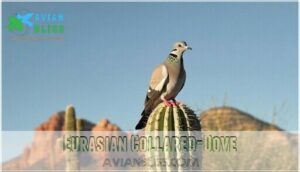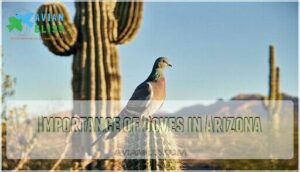This site is supported by our readers. We may earn a commission, at no cost to you, if you purchase through links.
 You’ll find six dove species calling Arizona home, each perfectly adapted to the state’s diverse landscapes from desert floors to mountain forests.
You’ll find six dove species calling Arizona home, each perfectly adapted to the state’s diverse landscapes from desert floors to mountain forests.
The Mourning Dove dominates backyard feeders statewide, while White-winged Doves migrate seasonally to pollinate saguaro cacti in the Sonoran Desert.
Urban areas host year-round populations of Inca Doves and invasive Eurasian Collared-Doves, while Common Ground Doves prefer rural brushlands and Band-tailed Pigeons inhabit high-elevation pine forests.
These birds aren’t just beautiful visitors—they’re essential ecosystem engineers, dispersing seeds across vast distances and maintaining Arizona’s plant diversity, with each species bringing unique behaviors, calls, and ecological roles that’ll surprise you once you know what to look for, showcasing their importance as diverse landscapes inhabitants.
Table Of Contents
- Key Takeaways
- Mourning Dove
- White-winged Dove
- Inca Dove
- Common Ground Dove
- Band-tailed Pigeon
- Eurasian Collared-Dove
- Natural History of Arizona’s Doves
- Importance of Doves in Arizona
- Interaction With Humans
- Conservation Efforts
- Frequently Asked Questions (FAQs)
- What type of doves live in Arizona?
- What is dove season in Arizona?
- What does it mean when a mourning dove sits on your porch?
- Are Inca doves rare in Arizona?
- Is it good to have doves in your yard?
- Why do doves hang around your house?
- Is it legal to shoot doves in AZ?
- What is the difference between a mourning dove and a White-winged Dove?
- How do doves communicate with their mates?
- What predators threaten dove populations in Arizona?
- Conclusion
Key Takeaways
- You’ll find six dove species in Arizona, each adapted to specific habitats from desert floors to mountain forests, with Mourning Doves being the most common statewide visitors to backyard feeders.
- You can easily identify each species by their distinctive calls and behaviors – Mourning Doves produce mournful cooing, White-winged Doves make owl-like hoots, and Inca Doves repeat gentle "no-hope" sounds.
- These birds serve as essential ecosystem engineers, with White-winged Doves pollinating saguaro cacti and all species dispersing seeds across vast distances to maintain Arizona’s plant diversity.
- You’ll encounter different species based on elevation and habitat – urban areas host Mourning, Inca, and invasive Eurasian Collared-Doves, while desert regions support White-winged and Common Ground Doves, and mountain forests house Band-tailed Pigeons.
Mourning Dove
You’ll recognize the Mourning Dove as Arizona’s most abundant dove species, easily spotted at backyard feeders and perched on power lines throughout the state.
Arizona’s most familiar dove graces every neighborhood with its gentle presence and haunting calls.
Their distinctive mournful cooing call echoes across neighborhoods and open spaces, making them one of the most familiar sounds in Arizona’s birding landscape.
Mourning Dove Range Map
You’ll find Mourning Doves across Arizona’s diverse landscapes year-round, from desert floors to mountain foothills.
Their range expansion shows strong habitat correlation with human settlements, creating high population density in urban areas.
Mapping accuracy reveals consistent distribution statewide, with minimal seasonal variation compared to other Arizona doves.
This widespread presence makes them Arizona’s most accessible dove species for observation.
Most Common Dove in Arizona
Throughout Arizona’s diverse landscapes, you’ll encounter the Mourning Dove more than any other dove species.
These adaptable birds thrive in urban neighborhoods, desert washes, and agricultural areas thanks to their flexible Habitat Preference and resilient Population Dynamics.
Their remarkable Breeding Success stems from year-round nesting capabilities, while their varied Feeding Ecology helps them exploit abundant seed sources across different environments.
Visitors to Bird Feeding Stations
Arizona birds frequently visit backyard bird feeders, especially Mourning Doves seeking their preferred seeds.
These urban habituation experts adapt well to residential feeding stations throughout seasonal variation periods. You can easily find quality mourning dove feed online.
- Seed Preferences: Offer millet, safflower, and cracked corn for ideal dove diet attraction
- Feeder Types: Use platform or ground-level bird feeders for comfortable access
- Competition Dynamics: Place feeders in open areas where doves can easily spot approaching threats
Distinct Calls of Mourning Doves
You’ll recognize mourning doves arizona by their haunting, melancholy calls that echo through desert mornings.
These bird calls feature distinctive cooing patterns with call variations that develop through vocalization development.
Acoustic communication includes soft "coo-OO-oo-oo" sequences, while regional dialects emerge based on environmental impact on local populations.
| Call Type | Description | Best Hearing Time |
|---|---|---|
| Territorial Coo | Deep, resonant "whooo-oo-oo-oo" | Dawn/Dusk |
| Mating Call | Soft, rhythmic cooing sequence | Spring Breeding |
| Alarm Note | Sharp, abbreviated "coo" | When Threatened |
| Contact Call | Gentle "oo-ah-oo" between pairs | Throughout Day |
White-winged Dove
You’ll recognize the White-winged Dove by its striking white wing patches that flash during flight, making it one of Arizona’s most distinctive summer visitors.
This desert specialist arrives from Mexico each spring to breed in the Sonoran Desert, where it plays a vital role pollinating saguaro cacti and dispersing seeds across the landscape.
White-winged Dove Range Map
You’ll find White-winged Doves across southern and central Arizona, with their range expansion continuing northward due to climate impact and habitat changes.
These arizona dove species adapt well to desert doves environments, showing remarkable population density in urban areas.
Here’s their current distribution pattern:
- Primary range: Sonoran Desert regions with heavy saguaro populations
- Migration routes: Seasonal movement between Mexico and Arizona breeding grounds
- Expanding territory: Moving into new arizona birding locations as dove habitat evolves
Their whitewinged dove populations concentrate where desert meets development, making arizona dove species identification easier for observers.
Desert Habitat & Migration Patterns
White-winged Doves showcase remarkable desert adaptations, arriving in Arizona during spring migration when saguaro cacti begin fruiting.
These desert birds time their migration triggers perfectly with seed availability, traveling up to 25 miles for water sources.
Their nesting strategies center around desert doves’ water dependence, utilizing mesquite and cholla cactus habitats.
Arizona dove species like these demonstrate how dove habitat and dove migration patterns align with desert survival needs, and also rely on saguaro fruit for moisture in the harsh desert environment.
Essential Role as Pollinators & Seed Dispersers
You’ll discover these birds are nature’s hardworking partners in Arizona’s delicate ecosystem.
White-winged doves maintain critical relationships with desert plants through their specialized feeding habits and movement patterns.
- Saguaro cactus pollination – Doves transfer pollen between blooms while feeding on nectar
- Seed dispersal methods – Birds carry seeds across vast distances in their digestive systems
- Native plant regeneration – Deposited seeds establish new vegetation in suitable habitats
- Ecosystem impact – Dove dietary habits support biodiversity across Arizona wildlife corridors
- Desert connectivity – Migration patterns link fragmented habitats through seed transport
Inca Dove
You’ll recognize Inca Doves by their distinctive scaly plumage pattern and their remarkable ability to breed year-round in Arizona’s urban areas.
These small, ground-dwelling doves have adapted so well to city life that they’re now among the most common backyard birds in the southwestern part of the state.
Inca Dove Range Map
Throughout southwestern Arizona’s Sonoran Desert region, you’ll spot Inca doves thriving in urban areas.
Where Urban Adaptation meets Climate Influence, this Range Expansion shows strong Habitat Correlation with human settlements.
Future Projections suggest continued growth as these non-migratory dove species excel at bird identification challenges across their Arizona bird range.
Longest Breeding Season in Arizona
The Inca Dove holds Arizona’s record for the longest breeding season, extending January through November.
Environmental factors like monsoon rains and resource availability trigger multiple broods annually.
You’ll find their nesting frequency peaks during favorable conditions, with pairs producing up to five clutches per year.
This extended reproductive period gives Inca doves a significant advantage over other Arizona bird species in population growth.
Abundance in Southwestern Urban Areas
Following their extended breeding season, Inca Doves have become surprisingly common fixtures in southwestern cities.
After house sparrows, they’re the most abundant urban bird species in the region. You’ll find these adaptable doves thriving in arizona wildlife hotspots where Human-Dove Interactions create perfect conditions for Urban Dove Ecology success.
Arizona is actually home to a total of seven distinct dove species.
- City Adaptation Strategies include utilizing building ledges, telephone wires, and landscaped areas as prime nesting sites
- Feeding Resource Availability from urban environments supports larger dove population densities than natural desert habitats
- Population Density Factors in urban areas exceed rural populations due to consistent food sources and protected roosting locations
Common Ground Dove
You’ll find Arizona’s smallest dove species foraging quietly on the ground in southern parts of the state.
This sparrow-sized bird with brownish-gray plumage and chestnut wing patches blends perfectly with desert soil, making it challenging to spot until it moves.
It has brownish-gray plumage that helps it blend in with its surroundings.
Common Ground Dove Range Map
Common Ground Doves occupy a surprisingly narrow range in Arizona compared to their cousins.
You’ll spot these sparrow-sized birds primarily in southern Arizona’s desert scrub and riparian areas, with scattered populations in central regions.
Climate change and habitat fragmentation threaten their limited distribution, making conservation status monitoring essential.
Range expansion northward remains unlikely due to temperature constraints, though future projections suggest potential shifts in bird habitat preferences across Arizona’s diverse landscapes.
Habitat Preferences and Behavior
You’ll discover Common Ground Doves in Arizona’s brushy desert areas and riparian zones where dense vegetation provides perfect cover.
Their nesting habits showcase fascinating details, building simple platforms in low shrubs or directly on the ground.
Their foraging strategies focus on seeds scattered across open patches between shrubs.
Social behavior remains relatively solitary except during breeding season.
Roosting locations include thick brush that offers protection from predators.
Daily activity peaks during cooler morning and evening hours when these doves search for food and water sources.
Band-tailed Pigeon
You’ll find Band-tailed Pigeons in Arizona’s higher elevation forests, particularly in oak and pine woodlands above 4,000 feet where they feed on acorns and berries.
These larger members of the dove family prefer cooler mountain habitats and aren’t typically seen in the desert regions where other Arizona doves thrive.
Band-tailed Pigeon Range Map
Band-tailed Pigeons span from British Columbia to Mexico, with Arizona representing the species’ southern range limits.
These forest dwellers prefer mountainous terrain above 5,000 feet elevation, making Arizona Distribution somewhat limited compared to other dove species.
Key Range Factors affecting Bandtailed Pigeon populations include:
- Elevation requirements – They need cooler mountain forests
- Oak woodland availability – Essential for acorn feeding
- Water source proximity – Critical during Arizona’s dry seasons
- Seasonal Migration Patterns – Move between breeding and wintering grounds
- Population Density variations – Fluctuate based on food availability
Arizona’s sky islands provide perfect Pigeon Habitat for birdwatching in Arizona enthusiasts seeking this elusive Arizona bird species.
Their diet shifts seasonally, influenced by available food sources.
Feeding Habits and Habitat
Discovering Band-tailed Pigeons means venturing into Arizona’s montane forests where these secretive birds thrive.
Their habitat preferences center on dense woodland cover in desert regions, while their feeding habits focus on nuts, acorns, and seasonal food sources.
These feeding adaptations help doves disperse seeds throughout riparian areas.
Their preferred nesting locations are often in dense forests.
Their diet includes:
- Oak acorns cracking beneath powerful beaks in autumn shadows
- Wild berries staining their bills purple during summer foraging
- Pine nuts scattered across forest floors like nature’s treasure
Unlike urban dove diets, Band-tailed Pigeons avoid human settlements, preferring Arizona’s remote mountain habitats where patience rewards dedicated birdwatchers.
Eurasian Collared-Dove
You’ll recognize the Eurasian Collared-Dove by its distinctive black neck collar and larger size compared to most Arizona doves.
This introduced species has rapidly expanded across the state since the 1970s and can now be hunted year-round without bag limits.
Eurasian Collared-Dove Range Map
The Eurasian Collared-Dove’s range map reveals remarkable Expansion Factors across Arizona since the 1980s.
Population Density clusters around urban centers where Habitat Correlation shows strong ties to human settlements. You’ll find these dove species thriving in Phoenix, Tucson, and smaller towns throughout the state.
Mapping Accuracy improves annually as birdwatching enthusiasts document their spread.
Future Projections suggest continued growth, with doves in Arizona expanding into previously unoccupied desert regions. Their adaptability makes them successful colonizers.
Characteristics and Invasive Status in Arizona
The Eurasian Collared-Dove stands out as Arizona’s most recognizable invasive species among doves.
You’ll identify this medium-sized bird by its distinctive black collar marking, chalky gray-brown plumage, and squared tail with white edges.
Since arriving in the early 2000s, these adaptable birds have spread rapidly across Arizona’s urban and agricultural areas.
Key identification features include:
- Physical Traits: Black crescent collar on neck, pinkish head/breast, larger than Mourning Doves
- Habitat Adaptation: Thrives in cities, suburbs, and farmland with year-round breeding capability
- Invasive Impact: Competes aggressively with native doves for nesting sites and food sources.
Their population trends show explosive growth, prompting Arizona’s year-round hunting seasons with no bag limits to control their spread.
Natural History of Arizona’s Doves
Arizona’s doves have adapted to three distinct habitat types: urban areas where they thrive near human settlements, desert regions with sparse vegetation, and riparian zones along water sources.
Each species exhibits unique vocalizations, nesting behaviors, and dietary preferences that reflect their evolutionary adaptations to Arizona’s diverse landscapes, showcasing their ability to thrive in various environments with distinct characteristics.
Distribution in Different Habitats
Since Arizona’s diverse landscapes create distinct niches, each dove species shows clear habitat preferences and altitudinal distribution patterns.
| Species | Primary Habitat |
|---|---|
| Mourning Dove | Urban dove habitats, agricultural areas |
| White-winged Dove | Desert regions, saguaro communities |
| Inca Dove | Urban settlements, suburban parks |
| Common Ground-Dove | Riparian areas, dense desert scrub |
These habitat-specific adaptations allow doves to thrive across Arizona’s elevation zones, from desert valleys to mountain foothills, maximizing available resources.
Habitat restoration projects are essential for supporting bird populations, which is crucial for maintaining ecological balance and preserving the natural beauty of Arizona’s landscapes, including desert valleys and mountain foothills.
Vocalizations, Nests, and Diets of Each Species
You’ll recognize each dove species through their distinct dove calls and behaviors.
Mourning doves produce soft, melancholy coos while foraging for seeds on open ground. White-winged doves create loud, owl-like hoots and prefer saguaro cactus fruits.
Inca dove vocalizations include gentle, repetitive "no-hope" calls as they search urban areas for small seeds.
All species construct flimsy nesting materials of twigs and grasses.
Their diet variations reflect habitat preferences, with seed preferences ranging from mesquite beans to backyard birdseed, showcasing diverse foraging behavior across Arizona’s landscapes.
Importance of Doves in Arizona
Arizona’s doves serve as essential ecosystem engineers, pollinating desert plants like saguaro cacti and dispersing seeds across vast landscapes.
You’ll find these birds maintaining biodiversity by connecting plant communities and supporting food webs throughout the state’s diverse habitats.
Impact on Ecosystems and Pollination
Pollination services from doves create thriving ecosystems across Arizona’s diverse habitats.
These birds maintain ecosystem balance through their specialized dove diet, directly influencing plant growth and soil health.
Their habitat influence extends beyond simple seed consumption:
- Saguaro survival – White-winged doves guarantee desert icon reproduction
- Drought resilience – Native plants persist through dove-assisted dispersal
- Community stability – Diverse ecosystems flourish through dove interactions
Seeds pass through dove digestive systems undamaged, creating natural restoration cycles that support Arizona’s unique desert communities.
Role in Seed Dispersal and Biodiversity
Arizona’s doves act as Ecosystem Engineers, moving seeds across landscapes through their feeding patterns.
These Dove-Plant Interactions support plant growth and maintain Habitat Health in desert environments.
Their Seed Dispersal Mechanisms create new vegetation patches, boosting biodiversity throughout Arizona ecosystems.
Without these feathered gardeners, many native plants would struggle to colonize new areas and maintain genetic diversity.
Interaction With Humans
You’ll encounter Arizona’s doves regularly in cities and towns, where they’ve adapted remarkably well to human environments by nesting in buildings and feeding at backyard stations.
Arizona’s hunting regulations allow specific seasons for mourning and white-winged doves while encouraging year-round removal of invasive Eurasian collared-doves to protect native species.
Doves in Urban and Suburban Areas
You’ll find doves throughout Arizona’s Urban Adaptation zones, with species like Mourning Doves and Inca Doves thriving in Suburban Habitats.
These birds showcase remarkable Feeding Ecology flexibility, utilizing bird feeders and Human Interaction opportunities. Consider buying dove feeders to attract these birds to your yard.
Their Nesting Strategies adapt brilliantly to urban areas and suburban areas across Arizona.
- Resource competition – Invasive species compete with native doves for food sources
- Population pressure – Rapidly expanding non-native populations disrupt local ecosystems
- Disease transmission – Dense urban dove populations can spread pathogens to wildlife
Hunting Regulations in Arizona
Beyond urban environments, dove hunting regulations help manage healthy populations through careful oversight.
You’ll need a valid Arizona hunting license plus migratory bird stamp for mourning and white-winged doves. Season dates run September 1-15 and November 21-January 4, with bag limits of 15 daily (10 white-winged max).
Non-toxic shot requirements vary by location. Ethical hunting practices include proper species identification and retrieving downed birds.
Arizona’s diverse habitats support desert-adapted bird species, influencing hunting locations.
| Regulation Type | Requirements |
|---|---|
| License & Permits | Hunting license + migratory bird stamp |
| Bag Limits | 15 daily (10 white-winged max) |
| Shot Requirements | Non-toxic in select refuges |
Conservation Efforts
You’ll find that Arizona’s dove populations benefit from active management by the Arizona Game and Fish Department, which conducts annual surveys and monitors hunting harvests to guarantee sustainable numbers.
The department uses adaptive regulations and habitat protection measures to balance conservation needs with hunting opportunities while addressing threats like habitat loss and invasive species, ensuring the long-term health of the dove populations through habitat protection.
Arizona Game and Fish Department’s Mission
The Arizona Game and Fish Department champions dove conservation through thorough Population Management and strategic Habitat Conservation initiatives.
You’ll appreciate their commitment to Species Monitoring, Public Education, and balanced Hunting Regulations that protect Arizona fauna while supporting sustainable outdoor recreation.
Their dove conservation efforts guarantee these beloved birds thrive across Arizona’s diverse landscapes for future generations.
Management and Protection of Dove Species
Effective dove conservation requires coordinated management strategies that protect native species while controlling invasive populations.
You can support these critical dove conservation efforts through responsible practices and community engagement.
- Habitat Preservation – Maintain native vegetation and water sources that support dove nesting and foraging needs
- Hunting Regulations – Follow established bag limits and seasonal restrictions to guarantee sustainable dove population levels
- Invasive Species monitoring – Report Eurasian Collared-Dove sightings to help track their spread and impact
- Pesticide Impact reduction – Use wildlife-friendly pest control methods that don’t harm dove food sources
- Population Monitoring – Participate in citizen science projects that track dove research and conservation initiatives
Frequently Asked Questions (FAQs)
What type of doves live in Arizona?
You’ll discover seven dove species across the state, including Mourning Doves, White-winged Doves, and Eurasian Collared-Doves as the most common backyard visitors throughout Arizona.
What is dove season in Arizona?
Arizona’s dove hunting season runs September 1-15 and November 21-January 4 for Mourning and White-winged Doves, with a 15-bird daily limit. You can hunt Eurasian Collared-Doves year-round without limits.
What does it mean when a mourning dove sits on your porch?
Wonder why this gentle bird’s chosen your space?
A mourning dove on your porch typically indicates it’s found a safe, sheltered spot with potential food sources nearby, not any mystical meaning.
Are Inca doves rare in Arizona?
No, Inca doves aren’t rare in Arizona.
You’ll commonly find them throughout the southern half of the state, especially around human settlements, parks, and urban areas where they’ve adapted well to city life.
Is it good to have doves in your yard?
Like Noah’s doves bringing hope, these gentle birds offer your yard natural pest control, seed dispersal, and peaceful cooing sounds.
They’re beneficial visitors that eat insects and weeds while adding wildlife charm to your space.
Why do doves hang around your house?
Doves hang around your house because you’re providing what they need most: food sources like seeds, water for drinking, and safe nesting spots in trees or structures.
Is it legal to shoot doves in AZ?
Yes, shooting doves in Arizona is legal during designated hunting seasons.
Like following a treasure map, you’ll need the proper licenses and must respect bag limits.
Mourning and White-winged Doves have split seasons with daily limits, while Eurasian Collared-Doves can be hunted year-round.
What is the difference between a mourning dove and a White-winged Dove?
You’ll spot the difference easily: mourning doves have grayish-brown bodies with pointed wings and small black facial dots.
While white-winged doves display distinctive bright white wing stripes and black cheek spots.
How do doves communicate with their mates?
Ironically, while doves seem peaceful and quiet, they’re actually quite vocal communicators.
You’ll hear them use soft cooing sounds, body language like head bobbing, and preening behaviors to bond with their mates and strengthen pair relationships, which is a key aspect of their vocal nature.
What predators threaten dove populations in Arizona?
Hawks, owls, snakes, and feral cats pose the greatest threats to Arizona’s dove populations.
You’ll find raptors hunting during daylight while owls strike at dawn and dusk, making ground-nesting species particularly vulnerable.
Conclusion
Ready to transform your Arizona backyard into a dove-watching paradise?
Understanding the six doves in Arizona opens up incredible opportunities for observation and conservation.
From the Mourning Dove’s gentle cooing at your feeder to the White-winged Dove’s essential pollination work in saguaro forests, each species contributes uniquely to Arizona’s ecosystem.
You’ll now recognize their distinct calls, habitats, and behaviors while appreciating their important roles in seed dispersal and biodiversity maintenance across the state’s diverse landscapes.
















